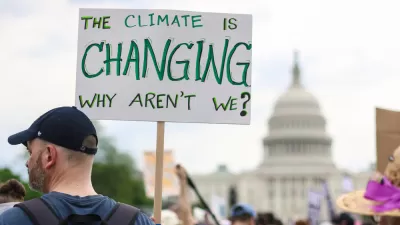New studies published this week challenge the 2 degree Celsius global warming threshold and call for an early warning system to monitor climate shifts.
"Ever since the 2009 climate talks in Copenhagen, world leaders have agreed on 2 degrees Celsius (3.6 degrees F) as the maximum acceptable global warming above pre-industrial levels to avert the worst impacts of climate change (today we’re at about 0.8 degrees C)," writes Tim McDonnell. "But a new study, led by climatologist James Hansen of Columbia University, argues that pollution plans aimed at that target would still result in 'disastrous consequences,' from rampant sea-level rise to widespread extinction."
The study, which was co-authored by Columbia economist Jeffrey Sachs and published in the journal PLOS ONE, concludes that "[f]ossil fuel emissions must be kept to [500 billion metric tons] and global warming held to about 1.8 degrees to avert disastrous consequences," notes Tony Barboza in the Los Angeles Times.
Barbosa also looks at a new National Research Council report that raises the spectre of sudden shifts in natural and human systems resulting from changes to the climate. To prepare for such threats, the report "[calls] for an early warning system to anticipate sudden climate shifts."
"'We watch our streets, we watch our banks ... but we do not watch our environment with the same amount of care and zeal,' said James White, a climatologist at the University of Colorado, Boulder and chairman of the committee that wrote the report."
FULL STORY: Scientists: Current international warming target is “disastrous”

Planetizen Federal Action Tracker
A weekly monitor of how Trump’s orders and actions are impacting planners and planning in America.

Maui's Vacation Rental Debate Turns Ugly
Verbal attacks, misinformation campaigns and fistfights plague a high-stakes debate to convert thousands of vacation rentals into long-term housing.

San Francisco Suspends Traffic Calming Amidst Record Deaths
Citing “a challenging fiscal landscape,” the city will cease the program on the heels of 42 traffic deaths, including 24 pedestrians.

Amtrak Rolls Out New Orleans to Alabama “Mardi Gras” Train
The new service will operate morning and evening departures between Mobile and New Orleans.

The Subversive Car-Free Guide to Trump's Great American Road Trip
Car-free ways to access Chicagoland’s best tourist attractions.

San Antonio and Austin are Fusing Into one Massive Megaregion
The region spanning the two central Texas cities is growing fast, posing challenges for local infrastructure and water supplies.
Urban Design for Planners 1: Software Tools
This six-course series explores essential urban design concepts using open source software and equips planners with the tools they need to participate fully in the urban design process.
Planning for Universal Design
Learn the tools for implementing Universal Design in planning regulations.
Heyer Gruel & Associates PA
JM Goldson LLC
Custer County Colorado
City of Camden Redevelopment Agency
City of Astoria
Transportation Research & Education Center (TREC) at Portland State University
Jefferson Parish Government
Camden Redevelopment Agency
City of Claremont





























